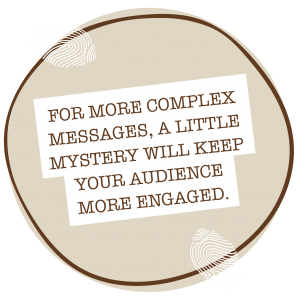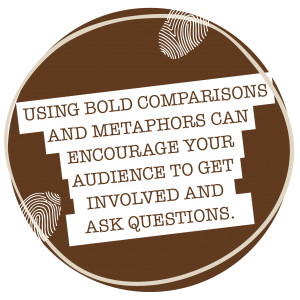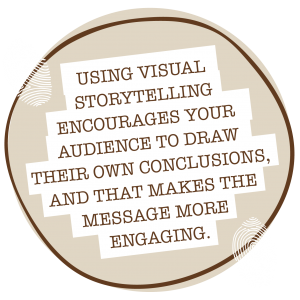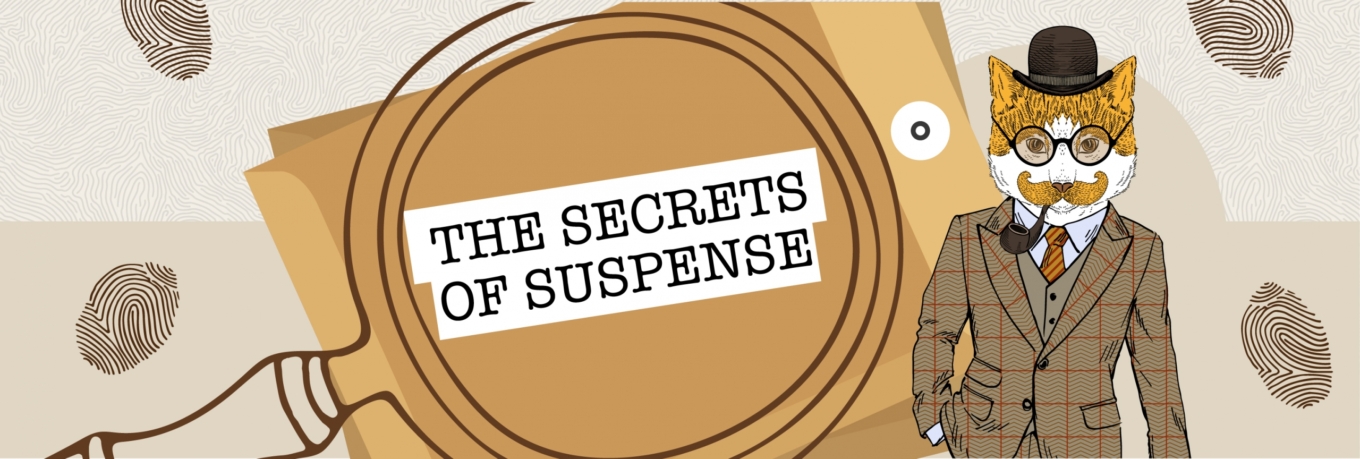You’re reaching the end of that gripping novel, and can’t put it down. Or watching the latest drama on Netflix. Just one more episode before bed…
What motivates you to keep going? It’s simple: you’re intrigued. You have questions. You want to know what happens.
Humans are curious creatures. If we weren’t, we’d never have invented the wheel, the steam engine or velcro. As communicators, we can use that curiosity to our advantage.
In a world where we’re assailed with messages every minute of the day, suspense can give us the edge in making our own communications more memorable.
You don’t need to be a budding Agatha Christie or Alfred Hitchcock either. Just use these tactics to ramp up the suspense and create a more engaging message.
Build a sense of mystery
In business writing we’re encouraged to get to the point quickly. But for more complex messages, we need to hold our audience’s attention for longer. The question is: how?
Robert Cialdini, author of Influence: the Psychology of Persuasion, found that the most effective science writing draws heavily on the conventions of a mystery novel. It begins with an intriguing puzzle, then gradually reveals the answer much as a mystery slowly unveils the culprit.
The same technique can be effective for business scenarios. Whether you’re making the case for a major change programme or sharing the results of your latest customer research, a little mystery will keep your audience more engaged.
Incorporate teasers in your campaigns
The first trailer of any major blockbuster is usually a teaser, revealing a hint of the characters and plot without giving too much away. It builds intrigue, anticipation and advance publicity.
Teaser campaigns are often used for marketing but they can be effective for internal comms too – especially for major campaigns or launches.
So consider how you can use teasers to build suspense – through posters, intranet banners or social media. Think clever imagery, countdown clocks or teasing text to stimulate interest and get people talking.
Make provocative statements
‘Passwords are like Pants’ declared a recent internal comms poster for Dorset Councils Partnership.
It’s a statement that creates an immediate sense of intrigue. Really? How?
A potentially staid message now has the viewer pondering the unlikely similarities between their IT security and their underwear. A healthy jolt of humour makes the message even more memorable.
Using bold comparisons and metaphors in this way can encourage your audience to ask questions. When they’re asking questions, they’re intrigued to discover the answers – and a lot more likely to remember them. 
Use a question pitch
If you have a strong argument, a simple question can be a powerful persuader. In To Sell is Human, Dan Pink calls this the ‘question pitch’.
In 1980, Ronald Reagan posed Americans a simple question whilst running for president: “Before you vote, ask yourself if you are better off today than you were four years ago.”
Reagan could simply have declared: “your economic situation has worsened in the last four years”. But a question compels your audience to respond, at least in their mind: to think for themselves and come to their own conclusion.
And when they develop their own reasons for agreeing, research suggests they endorse that belief more strongly and become more likely to act on it.
Inject drama into stories
Stories are the perfect vehicle for creating suspense. But they need a key element: drama. It’s drama that creates interest, leaving you impatient to know the outcome.
Many popular movies are based on familiar story structures, such as the Hero’s Journey. In his book Five Stars, communications consultant Carmine Gallo recommends the three-act structure used by almost all Hollywood movies:
- Act 1: Set-up – describing the status quo
- Act 2: Confrontation – the event that throws the status quo upside down, creating obstacles and challenges to overcome
- Act 3: Resolution – the problem is solved, and the world is a better place as a result
This simple structure can be used to add drama to any story, whether in a presentation or as the basis for a wider communications campaign.
Use visual storytelling
Soviet Union President Mikhail Gorbachev once said that it is better to see once than hear a hundred times.
That’s because we‘re hard-wired to process visual information. It comes down to the old adage of show, not tell – providing just enough information for our audience to fill in the gaps for themselves.
In the first scene of the movie Super 8, for example, a large safety sign at a steelworks reveals it’s been 784 days since the last accident. Slowly, a worker takes down the numbers and replaces them with a single zero.
One scene. No words. But now we know there’s been an accident, the first for a long time. And we’re starting to ask questions. What was it? And who was hurt? 
Using visual storytelling not only creates interest, it encourages your audience to draw their own conclusions, and that makes the message more engaging.
Ramp up the suspense in presentations
In 2007, Apple CEO Steve Jobs opened a memorable keynote speech by announcing the launch of not one product, but three: a widescreen iPod with touch controls, a revolutionary mobile phone, and a breakthrough Internet communications device.
Only after repeating this several times did he unveil the surprise: this was one device, not three: the iPhone.
Jobs created similar suspense when launching the MacBook Air a year later. Rather than telling us how thin it was, Jobs showed us – memorably pulling it out of an A4 manila office envelope.
You may not be launching a new product, but you can use similar techniques to slowly reveal the novel, surprising or counterintuitive elements of your message.
With a little creativity and effort we can create suspense in all kinds of communications. And just like that captivating novel or Netflix drama, your audience will be hanging on till the end of your message – and far more likely to remember it.
By Dave Wraith for Alive!
















